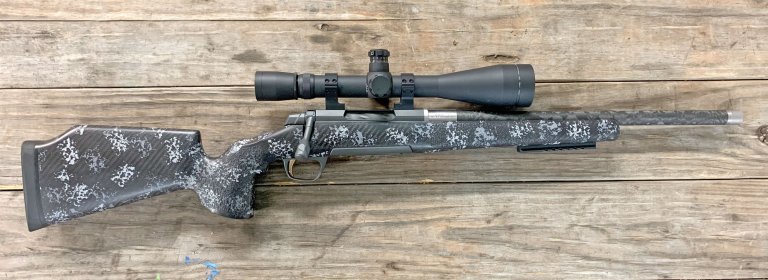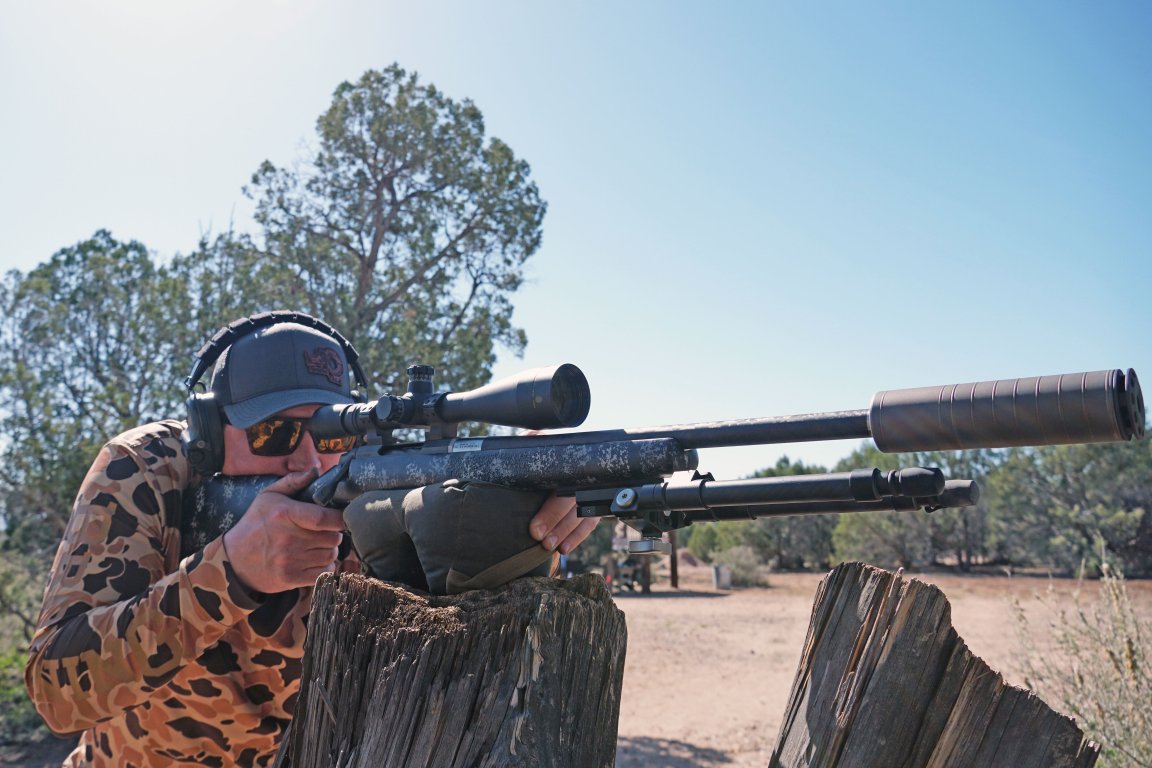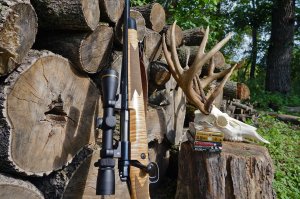We may earn revenue from the products available on this page and participate in affiliate programs. Learn More ›
Browning’s X-Bolt has become one of the best flagship bolt rifle models of our era, and this year, they’ve updated it with the X-Bolt 2. The X-Bolt 2 isn’t all that different from the original, but some changes include bolt fluting that allows more surface area contact between the receiver and bolt body for smoother operation and adoption of a new, cleaner-breaking DLX trigger. Base models come in a user-adjustable Vari-tech stock but, as with the existing X-Bolt line, the updated action is being offered in a number of tiered variations. A new addition to the line I was excited to see is the inclusion of carbon-wrapped barrels from Preferred Barrel Blanks. A current trend in lightweight hunting rifles is to go with a short 18- or 20-inch barrel topped with a suppressor and a target-style or folding chassis stock and the X-Bolt 2 Pro McMillan SPR Carbon Fiber is just such a gun — I couldn’t wait to get my grubby mitts on one.
Browning X Bolt 2 Pro McMillan SPR Carbon Fiber Specs

- Cartridges: 6.5 Creedmoor (tested), .308 Win., 6.5 PRC, 6.8 Western, 7mm PRC, .300 Win. Mag., .300 PRC
- Barrel: 18 inches, stainless, carbon-wrapped, 1:7 twist, threaded 5/8-24
- Receiver: X-Bolt 2, Cerakote finish
- Stock: McMillan Game Warden 2.0
- Trigger: Browning DLX, 3 pounds, 2 ounces (measured)
- Weight: 5 pounds, 13 ounces (measured)
- Price: $3,999
Key Features
- Updated bolt and receiver for smoother action
- New Browning DLX adjustable trigger
- McMillan foam/carbon-fiber stock has a thick vertical grip
- 18-inch Preferred carbon-wrapped barrel
- Muzzle threaded for suppressor or included brake
- Rotary magazine
- Aluminum Picatinny rail for mounting bipod
- Q.D. sling sockets
Review Highlights
- Compact and light
- Excellent accuracy
- Great trigger
- Optimized for hunting with a suppressor
- Ejecting cases still ding the Cerakote on the receiver
- Accuracy: .692 inches (average of 59 5-shot groups with 12 types of ammo)
Configuration as Tested
- Scope: Leupold Mark 4 ER/T 6.5-20 x 50mm TMR
- Scope Mount: Browning/Talley X-Bolt 30mm base/ring
- Bipod: Spartan Precision Kratos bipod
- Suppressors: Silencer Central Banish Backcountry and Silencerco Scythe Ti
Top Performing Ammunition
- Federal Premium 143-grain ELD-X (0.585-inch 5-shot average)
- Federal Gold Medal Center Strike 140-grain OTM (0.664-inch 5-shot average)
- Sako TRG 163-grain Scenar (.637-inch 5-shot average)
- Hornady Match 140-grain ELD-M (0.819-inch 5-shot average)
The Browning X-Bolt 2: Subtle Changes To Make A Good Action Better
The X-Bolt’s tenure as a dominant flagship rifle model is justified by performance. For mass-production guns, they’re reliably good-quality, accurate-shooting rifles. Even considering all the line extensions and upgraded models, the basic X-Bolt is still a fantastic hunting rifle. Both standard and some of the heavier-barreled models are quite accurate and firmly rooted in the mid-priced rifle category. For the X-Bolt 2, there’s no reason to ditch something that works so well, and some simple design changes only elevate the platform. Here are the basics on what has been updated:
Receiver-Bolt Interface
The X-Bolt has always been a relatively smooth action, but it can sometimes bind or feel sticky. To reduce wobble and make the action smoother, Browning has slightly lengthened the rear portion of the action to create more bearing surface with the bolt. They’ve also thickened the top of the receiver to give the scope mounting screws a stronger connection.
Re-designed Ejection Port
The new X-Bolt 2 receiver has a slightly re-designed ejection port that’s angled to enlarge the opening at the bottom of the port rather than the squared front and rear edges that the original X-Bolt has. The X-Bolt 2 receiver is still just Cerakote-finished steel. It’s solid and reliable, but I’d really like to see them dabble with titanium X-bolt actions.

DLX Trigger
The X-Bolt 2 comes with Browning’s new DLX trigger that is user-adjustable — though you must disassemble the gun — and cuts any trigger slop or overtravel down to nothing. It’s a pleasantly crisp-breaking trigger that’s adjustable down to 3 pounds. Mine came set just a few ounces heavier than that, and I had no reason to change it.
Vari-Tech Stock
Though the X-Bolt 2 Pro models have different stocks, the base models of the new X-Bolt have the new Vari-tech stock that has adjustable length of pull, comb height, and grip angle. It has similar ergonomics as previous X-Bolt stocks, but with more adjustability.
The X-Bolt 2 Pro McMillan SPR Carbon Fiber: What Goes Into A $4,000 Production Rifle?
If there’s anything that a discerning hunter might choke on when it comes to this top-tier X-Bolt, it’s the price. There’s no two ways about it, $4,000 is a lot of coin. That might make it a rifle that you have to thoughtfully save for, but we’ve got to see what we’re getting before making that judgment. This gun aims to fit into a strong category of premium hunting rifles from companies like Allterra Arms, Proof Research, Seekins Precision, and Weatherby that fall into similar (or higher) price ranges. Customers are willing to pay for quality, but the gun has got to bring the goods. For me, in order for a $4,000 rifle to justify its price, it needs to be nearly perfect. But what goes into a premium hunting rifle?
McMillan Game Warden 2.0 Stock
One of the premium components that this rifle sports is a Game Warden 2.0 stock made by McMillan. It’s a foam core wrapped in carbon fiber, and weighs only 1 pound, 12 ounces. Despite its feathery feel, this stock smartly incorporates ergonomic features of a target stock to make the rifle more manageable. Many ultralight hunting rifles — the Christensen Ridgeline FFT Ti for example — use traditional grip profiles and skinny forends, and they are tough to shoot accurately and consistently.

The thick vertical grip, reverse comb, and wide target forend on this Browning X-Bolt 2 provide the shooter with a better grip, more stable platform, and more consistent head position. Despite being light, the rifle sits securely on bags and, whether on a bipod, or braced, the grip aids with low-torque, rearward pressure and a consistent trigger squeeze. The fat grip fills the hand, and both it and the forend have rough, grippy texturing. There are gently scalloped-out thumb rests along either side of the tang that position the thumb for optimal grip pressure and to easily manipulate the tang safety. As a whole, these features give the shooter a much better sense of control and stability when shooting from various positions than you’ll get with many ultralight rifles.
Under the hood, the Game Warden 2.0 Stock on this X-Bolt 2 comes fitted with two aluminum bedding pillars. The rear pillar, just behind the magazine, has a portion hogged away because of how close the rear action screw is to the magazine. On top, the stock has bedding compound around both pillars, in the recoil lug recess, and a dab under the rearmost portion of the barrel. It’s not a full-tilt bedding job, but enough to ensure a repeatable, consistent fit.

Writers Don’t Get Cherry-Picked Rifles
One issue I did encounter with the stock dispels the myth that writers get hand-picked samples to review. The idea being that normal production models will be of lesser quality or produce worse accuracy than these “ringers.” Based on the small dents in the receiver’s Cerakote finish behind the ejection port, I could tell that this pre-production rifle had been fired quite a bit — likely a SHOT show demo gun. At early stages of production, samples aren’t always readily available. A nit-picky downside of the X-Bolt is that, at least with some cartridges, ejecting brass case necks tend to strike the rear portion of the receiver, chipping away at the finish.
An issue I quickly encountered was unreliable feeding, that I suspected might just be a magazine issue. A new mag didn’t fix it, so I tore the gun down and investigated further. Ultimately, I found that the inletting on the bottom of the stock (likely a McMillan issue, not Browning) had left the bottom of the rear bedding pillar (and the foam around it) extending too far down. Without screws, the bottom metal was high-centered and teetered on the rear pillar instead of fitting evenly and flush. This prevented the magazine from being held tightly against the receiver. I carefully removed about a sixteenth of an inch from the bottom side of the pillar and surrounding foam surface with a file, and the issue was cured.
Though this really was a minor issue, a $4,000 rifle shouldn’t get out the door with that kind of fitting problem. Browning would do well to keep an eye on that as rifles roll out.

A Premium Lightweight Barrel
A great barrel is key to a good-shooting rifle and, though we can sometimes be pleasantly surprised by cheaper guns that are real shooters, consistently great-shooting barrels are more expensive. The carbon-wrapped versions are even more expensive. These are the first X-Bolts to be offered with carbon-wrapped barrels — a feature that has been steadily growing in popularity for hunters who want premium accuracy and the associated weight savings they provide. On these X-Bolt 2 rifles, Browning is using barrels from Preferred Barrel Blanks, another company based in Utah. The stainless/carbon barrel on my sample is 18 inches long, threaded in ⅝-24 at the muzzle, and has a gently sloping target crown.
I’ve done a ton of shooting with this rifle, and have noted that it dissipates heat quickly — not all carbon-wrapped barrels are created equal. Also, it doesn’t seem to ever accumulate much fouling. I try to maintain pretty consistent barrel conditions when testing different ammo, and I’ve found this barrel to clean very quickly and it hasn’t ever built up much copper fouling at all. Even when I first received it — after being shot who knows how many times, there wasn’t really any copper to remove after I swabbed and brushed the carbon fouling out.
Other X-Bolt 2 Fare
Many features of the X-Bolt 2 Pro McMillan SPR Carbon Fiber will be familiar to X-Bolt shooters. It has a forward/backward sliding tang safety and a safety override button on the bolt that allows you to open the bolt while the safety is engaged. Otherwise, the bolt remains locked. LIke other X-Bolts, this rifle has a short 60-degree bolt throw to open its 3-lug action. Both action screws are forward of the trigger guard, straddling the magazine, and are specified to be torqued to 35 inch-pounds.
As mentioned earlier, this model uses the standard X-Bolt rotary magazine, but some other models utilize AICS-pattern magazines. Production rifles of this suppressor-ready model are to ship with one-piece Picatinny rails. Mine didn’t, but I actually prefer the lightweight Talley base/ring combo for a rifle like this. A big one-piece base just adds extra weight.
The Embodiment of a Modern Hunting Rifle
The wishes and whims of hunters vary frequently, but we all seem to value the same hunting rifle characteristics — albeit in varying proportions. Accuracy, weight, ergonomics, and handling characteristics are all important, and hunters have always been required to begrudgingly accept trade-offs. A sheep hunter must sacrifice some accuracy, ergonomics, or shootability if they want the lightest rifle possible to pack through the mountains. Hunters who don’t cover as much ground on their feet are often OK with a heavy, more cumbersome rifle because of its precision. These days, the lines between these previously independent attributes, and the sacrifices required, are getting blurry.
If you’d have told me 20 years ago that I’d see a sub-6-pound rifle with a McMillan target-style stock that was more accurate that any rifle I’d ever fired at the time, I’d call you crazy. But it’s the truth. This is a rifle that is just as suited to carrying in a backpack as pounding steel plates off a tripod. It’s not awkward to carry single-handed under the action, and it’s a rock-solid shooter in a variety of positions.

Alongside the exponential increase in the popularity of suppressors for hunting rifles, a notable trend has been to use shorter barrels that can be fitted with a suppressor and remain within a reasonable overall length. Cutting down the length of your barrel does come at a cost in velocity, but within reasonable hunting ranges, that doesn’t matter much. If you’re taking shots where that extra two or four inches of barrel length mean the difference between success and failure, I’d encourage you to rethink what you’re doing.
I did almost all my shooting with a Banish Backcountry and Silencerco Scythe Ti suppressor, and compared to my 26-inch barreled Ruger Precision Rifle, the 18-inch-barreled X-Bolt 2 averaged about 100 fps slower when comparing the same loads — that’s not significant. For testing, I topped the rifle with an older Leupold Mark 4 ER/T 6.5-20 x 50mm scope, but as a hunting rig, I’d pick a lightweight scope that topped out at around 14x magnification at most. I’d be perfectly happy with this rifle wearing a Leupold VX3HD 2.5-10x40mm CDS scope. Even with the unnecessarily heavy scope, bipod, and suppressor, the gun weighs only 9 pounds, 8 ounces, with an overall length of 43.75 inches.

Accuracy Testing the Browning X-Bolt 2 Pro McMillan SPR Carbon Fiber
I’ve already said that this rifle is accurate, but how accurate? I recorded an excessive amount of data with this X-Bolt 2 — partly because I couldn’t stop myself from shooting it. It shot so well that I impulsively used it to test every factory and hand-rolled 6.5 Creedmoor load I had on hand. In total, I recorded 59 5-shot groups with 12 different types of ammo. Those all averaged out to a group size of .692 inches. That’s incredible.
As part of our ever-continuing efforts to improve the quality and informative value of our accuracy data, the OL gun team has begun incorporating larger group sample sizes and more informative accuracy metrics like mean radius. A lot of the data I accumulated with this rifle was used to fine-tune and better understand how these two things can create a high-definition picture of a rifle’s accuracy and the role each shot plays. This is helpful to see differences in ammunition and rifles, but also debunks a lot of myths and small-sample illusions.
Read Next: Node Nonsense: How You’ve Been Wasting Your Time and Money on Load Development
The best-shooting load I tested in this rifle was Federal Premium’s 143-grain Hornady ELD-X load. This load averaged .585-inch 5-shot groups, and I recorded a 30-shot aggregate group size of .806 inches with a mean radius of .229 inches. Second to that, Federal Gold Medal Center Strike 140-grain OTM load averaged .664-inch 5-shot groups. It had a slightly smaller extreme spread for its 30-shot group at .762 inches, but its mean radius was a hair larger at .249 inches. That larger mean radius means that shots were distributed farther from the center of the group on average but, in this case, we are literally splitting hairs. They’re both excellent-shooting loads.
Slightly less accurate, the budget-priced Freedom Munitions 140-grain BTHP Match load averaged .968-inch 5-shot groups, and printed a 20-shot group of 1.523 inches with a mean radius of .395 inches. That means that the average shot impacted .395 inches from the center of the group over those 20 shots. Still not bad.
The takeaway here is that you probably won’t find a more accurate hunting-weight, compact rifle. If you do, you better not let it go. Rifles that can shoot some tight groups are common, but light, compact rifles that can do it every single time are uncommon.

What the Browning X-Bolt 2 Pro McMillan SPR Carbon Fiber Does Well
This Browning X-Bolt 2 effectively combines target rifle accuracy and ergonomics with the benefits of a light mountain rifle. It’s superbly accurate and pleasingly easy to shoot for a rifle that weighs so little. It’s a perfect suppressor host and hunting rifle for the modern age.
Where the Browning X-Bolt 2 Pro McMillan SPR Carbon Could Be Better
I don’t have complaints about this rifle, except for the long name. Considering the hefty price tag though, I’d like to see a little bit tighter fit tolerances between the stock and metal, and I’d like a solution to the chipping finish from ejecting brass. The fitting problem of my bottom metal was an issue, but I don’t expect that to be something that’s encountered on regular production models — so it’s not a reason to break out the pitchforks.
Final Thoughts on the Browning X-Bolt 2 Pro McMillan SPR Carbon
With the price of premium rifles comes high expectations. Like I said, for what many of these rifles go for, I expect perfection (or as close as possible). For that reason, some of my critiques might seem harsh, but they’re really all little things that I probably wouldn’t bother to address with mid-priced rifles. Whether they are deal-breakers is up to you. Are there ways that this rifle could be a little bit better? Sure, but that doesn’t change the fact that I really, really like this gun. You’ll be hard pressed to buy or build a similar rifle that shoots any better, and it’s unquestionably my favorite X-Bolt yet.

